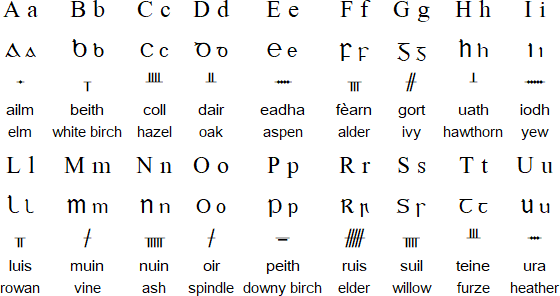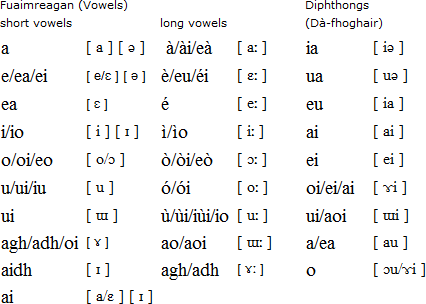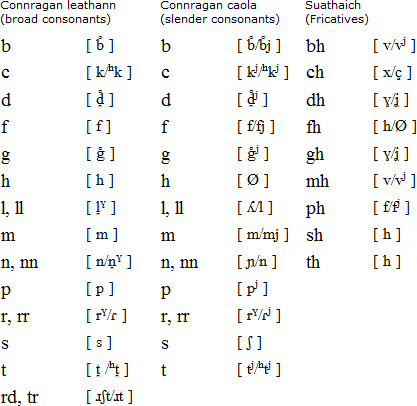Scottish Gaelic is spoken in Scotland (Alba), mainly in the Highlands (a' Ghaidhealtachd) and in the Western Isles (Na h-Eileanan an Iar), but also in Glasgow (Glaschu), Edinburgh (Dùn Eideann) and Inverness (Inbhir Nis). There are also small Gaelic-speaking communities in Canada, particularly in Nova Scotia (Alba Nuadh) and Prince Edward Island. Other speakers can be found in Australia (Astràilia), New Zealand (Sealainn Nuadh) and the USA (Na Stàitean Aonaichte).
According to the 2011 UK census, 87,100 people in Scotland reported having some knowledge of Scottish Gaelic. 32,400 could undertand, speak, read and write Gaelic, 57,600 could speak Gaelic, 6,100 could read and/or write Gaelic, but not speak it, and 23,400 could understand Gaelic, but not speak, read or write it. The areas with the highest proportion of Gaelic speakers (48.9%) were Highland, Eilean Siar (Western Isles) and Glasgow City. Overall 1.7% of the population of Scotland has some Gaelic [source].
In Canada, according to the 2016 census, Scottish Gaelic is a mother tongue, or the language spoken most often at home for 1,545 people [source].
Scottish Gaelic is classified as an indigenous language under the European Charter for Regional or Minority Languages, which has been ratified by the UK government. The body in charge of the development of Gaelic in Scotland is the Bòrd na Gàidhlig, which was set up in 2005.
It is thought that Scottish Gaelic developed from the Old Irish bought to Scotland in the 4th century AD by people known as Scotti from Ireland. They settled in what is now the west of Argyll and set up the Kingdom of Dál Riata. By the 9th century Scottish Gaelic had replaced the Pictish and Brythonic languages in much of Scotland, and by the early 11th century Gaelic was spoken throughtout Scotland, apart from in small areas in the southeast and northeast.
From the late 11th century in eastern parts of Scotland Gaelic was gradually replaced by the English of Northumbria, which was known as Inglis, and by Norman French. The nobility adopted Norman French, while the ordinary people spoke Inglis. In the mid-14th century Inglis, which by then was known as Scots, became the official language of government and law in Scotland.
From the 18th century children were punished for speaking Gaelic in schools set up by the Society in Scotland for the Propagation of Christian Knowledge. However, the Gaelic Schools Society, which was establised in 1811, taught Gaelic speakers to read their own language so that they could read the Bible in Gaelic. The full translation of the Bible into Gaelic was published in 1801, and became the standard for the written language.
The number of Gaelic speakers increased between 1755 and 1800 from 289,798 to 297,823, however since then there was been a steady decline.
The number of Gaelic speakers declined during the 18th and 19th centuries, when many were evicted from their land to make way for sheep farms. Many migrated to others parts of Scotland, to North America, and to Australia and New Zealand.
Gaelic speakers from Scotland began emigrating to Canada in 1773, and continued to do so until the 1850s. They settled mainly in Nova Scotia, mainly on Cape Breton Island and the northeast of the mainland of Nova Scotia. There were about 200,000 Gaelic speakers in Canada in 1850. However since then, the number has declined for a variety of resaons. During the early 20th century, for example, pupils in Nova Scotia were forbidden from speaking Gaelic in schools. This lead many Gaelic speaking parents to stop passing on Gaelic to their children as they believed fluency in English was more important.
Scottish Gaelic can be heard on the BBC radio staion Radio nan Gàidheal and on the television channel BBC Alba. There are also some Gaelic programmes on other channels. Gaelic is taught as a subject in some schools, and used as a medium of instruction in others. It also possible to study degrees through Gaelic as Sabhal Mòr Ostaig, a part of the University of the Highlands and Islands on the Isle of Skye.
The earliest identifiably texts in Scottish Gaelic are notes in the Book of Deer written in north eastern Scotland in the 12th century, although the existence of a common written Classical Gaelic concealed the extent of the divergence between Irish and Scottish Gaelic.
There is very little early literature in Scottish Gaelic as it was mainly an oral culture. A collection of poetry in Scottish Gaelic, The Book of the Dean of Lismore (Leabhar Deathan Lios Mòir), was compiled in manuscript form in the early 16th century. A Gaelic translation of the Book of Common Order was published in 1567, and is considered the first printed book in the language.
During the early 20th century only a few books in Scottish Gaelic were published each year. However, since the 1970s the number has increased to over 40 new books per year. Gaelic publications include novels, collections of poetry, biographies, and other books [source].
Scottish Gaelic is closely related to Manx and Irish. It is also more distantly related to Welsh (Cymraeg), Cornish (Kernewek) and Breton (Brezhoneg), which form the Brythonic branch of the Celtic languages, also known as P-Celtic. The Celtic languages all have a similar grammatical structure, but have less vocabulary in common.
Scottish Gaelic is written with 18 letters of the Latin alphabet. Traditionally each letter is named after a tree or shrub, however the names are no longer used. Inscriptions in Ogham have been found in Scotland, however it is not certain what language they are in. Some may be in Gaelic, others in Pictish. The Ogham equivalents of the Latin letters are shown below. The Gaelic Script is also shown, as it was used in Scotland, and is still used as a decorative script.

Hear the Scottish Gaelic alphabet:


The connragan leathann or broad consonants are those preceded or followed by a, o or u. Connragan caola or slender consonants are those preceded or followed by i or e. Most consonants have different pronunciations depending on whether they appear at the beginning of a word or elsewhere. In the chart above the broad pronunciations of the consonants are given in the first line below them, and the slender pronunciations in the second line. C, p and t are pre-aspirated between vowels, and unaspirated at the end of words.
The initial consonants of Gaelic words can change in various contexts. This process is known as "lenition" and involves the addition of an h after the initial letter. The resulting letters are suathaich or fricatives.
Source: http://www.akerbeltz.org/fuaimean/roradh.htm
Rugadh na h-uile duine saor agus co-ionnan nan urram 's nan còirichean. Tha iad reusanta is cogaiseach, agus bu chòir dhaibh a ghiùlain ris a chèile ann an spiorad bràthaireil.
Hear a recording of this text by Frederic (Calum) Bayer
All human beings are born free and equal in dignity and rights. They are endowed with reason and conscience and should act towards one another in a spirit of brotherhood.
(Article 1 of the Universal Declaration of Human Rights)
Information about Scottish Gaelic | Phrases | Numbers | Family words | Terms of endearment | Colours | Time | Dates | Comparison of Celtic languages | Celtic cognates | Celtiadur | Tower of Babel | Songs | Links | My podcast about Scottish Gaelic | Learning materials
Information about Scottish Gaelic
http://en.wikipedia.org/wiki/Scottish_Gaelic
http://www.gaelic.com
http://www.smo.uhi.ac.uk/gaidhlig/ionnsachadh/
https://en.wikipedia.org/wiki/Canadian_Gaelic
https://en.wikipedia.org/wiki/Scottish_Gaelic_grammar
https://en.wikipedia.org/wiki/Scottish_Gaelic_phonology
https://en.wikipedia.org/wiki/Scottish_Gaelic_orthography
https://en.wikipedia.org/wiki/Classical_Gaelic
https://en.wikipedia.org/wiki/Gaelic_medium_education_in_Scotland
Online Scottish Gaelic lessons
http://www.bbc.co.uk/scotland/alba/foghlam/beag_air_bheag/
http://www.smo.uhi.ac.uk/gaidhlig/ionnsachadh/bgfp/
http://www.smo.uhi.ac.uk/gaidhlig/ionnsachadh/ECG/
http://www.learngaelic.net/look/
http://polymath.org/gaelic.php
Breton, Celtiberian, Cornish, Cumbric, Gaulish, Irish, Lepontic, Lusitanian, Manx, Scottish Gaelic, Welsh
Languages written with the Latin alphabet
Page last modified: 21.12.24
[top]
You can support this site by Buying Me A Coffee, and if you like what you see on this page, you can use the buttons below to share it with people you know.

If you like this site and find it useful, you can support it by making a donation via PayPal or Patreon, or by contributing in other ways. Omniglot is how I make my living.
Note: all links on this site to Amazon.com, Amazon.co.uk
and Amazon.fr
are affiliate links. This means I earn a commission if you click on any of them and buy something. So by clicking on these links you can help to support this site.
[top]
Shipping time world-
wide is typically 6 days.